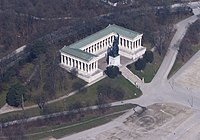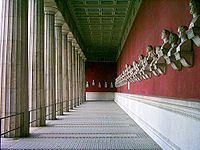Ruhmeshalle (Munich)
You can help expand this article with text translated from the corresponding article in German. (February 2012) Click [show] for important translation instructions.
|
This article includes a list of general references, but it lacks sufficient corresponding inline citations. (August 2019) |
The Ruhmeshalle (German pronunciation: [ˈʁuːməsˌhalə], lit. 'Hall of Fame') is a Doric colonnade with a main range and two wings, designed by Leo von Klenze for Ludwig I of Bavaria. Built in 1853, it is situated on an ancient ledge above the Theresienwiese in Munich and was built as part of a complex which also includes the Bavariapark and the Bavaria statue.[1] It is built of Kelheim limestone and is 68 metres long and 32 metres deep.
With the construction and exhibition of busts of important people from Bavaria, including the Palatinate, Franconia and Swabia, King Ludwig intended to create a hall of fame that honors laudable and distinguished people of his kingdom, as he did also in the Walhalla memorial for all of Germany.
In 1944, a bombing raid caused several busts' destruction.
-
The Ruhmeshalle with the statue of Bavaria by Ludwig Schwanthaler
-
Aerial photograph: Ruhmeshalle and Bavaria monument (2009)
-
Interior of the Ruhmeshalle
See also
[edit]- Befreiungshalle (Hall of Liberation, Kelheim, Germany)
- Heldenberg Memorial (Austria)
- Hermannsdenkmal (Hermann monument, Teutoburg Forest, Germany)
References
[edit]- ^ Colwell, Dan (2001). Munich. Hunter Publishing, Inc. p. 44.
External links
[edit]- Bayerische Schlösserverwaltung on the Ruhmeshalle
- Panorama of the Ruhmeshalle and the Bavaria statue



